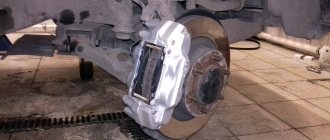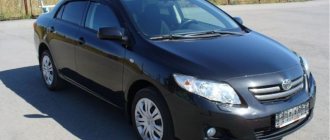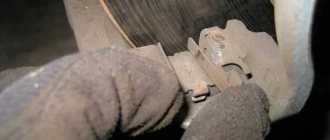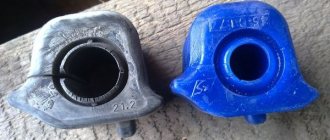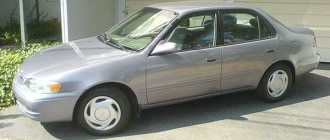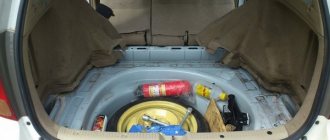Shock absorbers on the Toyota Corolla E120 and E150 will differ in size, not only between car generations, but also within a generation depending on the body type. In addition, the shock absorbers of the Corolla E120 differ from the E150 not only in rigidity and ground clearance within 5-6 cm, but also in fastening, in particular, on the E120 shock absorbers with PPD will differ in the holes for the steering tips, although the cups and supports (landing) are the same .
Structurally, the shock absorbers of the ninth and tenth generation Toyota Corolla consist of two pipes with gas-oil or oil filling. The supplier for the conveyor is Kayaba (KYB).
Front shock absorbers for Toyota Corolla E120
The front shock absorbers supplied for the ninth generation Corolla are divided into right-hand and left-hand. The original catalog number will differ depending on the body type and country of assembly of the car, but if necessary they can be interchanged. The technical characteristics of the front shock absorbers for the Toyota Corolla E120 are shown in the table: Original numbers and sizes of the front shock absorbers of the Toyota Corolla E120
| Original numbers and sizes of front shock absorbers Toyota Corolla E120 | |||||||
| vendor code | Assembly | Rod diameter, mm | Case diameter, mm | Length in compressed state, mm | Rod stroke, mm | price, rub. | |
| Left | Right | ||||||
| 4852080003 | 4851080103 | Europe+ UK (sedan, station wagon) | 22 | 51 | 336 | 184 | 6973 |
| 4851009711 | 4852009611 | 6713 | |||||
| 4852009890 | 4851009A60 | UK (hatchback) | 22 | 51 | 330 | 145 | 6271 |
Differences between shock absorber modifications
When completing technical equipment, including Toyota Corolla, shock absorbers are used - oil, gas, diesel.
- diesel fuel: the presence of gas in a ratio of 50/50 in relation to oil. The rod expands due to gas pressure. There is no need for a spring in the suspension design. The “shock absorber” type is ideal for urban conditions, megacities, and to a lesser extent for country roads due to greater rigidity;
- oil is one of the first projects, with its advantages and disadvantages. The rod works under compression, extraction occurs with the help of a spring. Effectively used on country roads and rough terrain. No other type of suspension can absorb shock as well as oil suspension. Minus: at medium and high speeds the body tilts when turning;
- gas: gas is introduced into the cavity of a high-pressure cylinder. The shock absorbers are quite durable and are completely unsuitable for use on rough terrain. Only car racing, autodromes.
Analogs of front shock absorbers for Toyota Corolla E120
When choosing to replace the original struts on a Toyota Corolla E120, you can find various options. As a rule, manufacturers offer two strut options for the front axle (depending on the country of manufacture), and the rear axle has the same shock absorbers. The most popular companies are shown in the table below. Kayaba supplies for sale struts of different series for both the front and rear axles (Excel G - standard, to replace the standard ones, Ultra SR - more rigid, for aggressive driving).
| Manufacturer | vendor code | Front left | Front right | price, rub. |
| KYB | WB | 334818 (Excel-G) 324701 (Ultra-SR) | 334817 (Excel-G) 324700 (Ultra-SR) | 3418/3386 4893/5255 |
| KYB | Japan (not for bad roads) | 333359 (Excel-G) | 333358 (Excel-G) | 5196/4990 |
| SACHS | WB Japan | 311914 312228 | 311913 312227 | 3477/3521 3037/12078 |
| Monroe* | WB Japan | E7010 | E7008 | 5919/3494 |
*According to the manufacturer Monroe, the article numbers of the sets are indicated on the axle (2 pieces in a package).
Shock absorber Toyota 4852080003
Shock absorber KYB 334818
Rear shock absorbers for Toyota Corolla E120
Unlike the front ones, the rear pillars are not divided into left-hand and right-hand. The original article number of the spare part differs depending on the body type and type of assembly of the car. Data on sizes and catalog numbers are given in the table.
| Original numbers and dimensions of rear shock absorbers Toyota Corolla E120 | ||||||
| vendor code | Assembly | Rod diameter, mm | Case diameter, mm | Length in compressed state, mm | Rod stroke, mm | price, rub. |
| 4853080309 | Europe | 22 | 51 | 379 | 193 | 6383 |
| 4853009F20 | UK (sedan, station wagon) | 6983 | ||||
| 4853009910 | UK (hatchback) | 4683 | ||||
Shock absorbers front and rear Toyota Corolla
5 out of 5 (5 ratings)
* Calculated based on Yandex Directory reviews
The factory produces gas, oil or gas-oil ones. Among the modifications and tuning - pneumatic versions. Toyota Corolla front shock absorbers are available assembled or separately in the form of a cartridge, the rear shock absorbers are usually in the form of a cartridge. It is better to replace shock absorbers in pairs, on the same axis. By replacing only one shock absorber, the car will most likely tilt and when braking, one side will sag more than the other. To use a rough analogy, after tearing one shoe, we buy a pair.
You can buy it assembled with a stand or in the form of a cartridge. Even if you find a cartridge that costs less than an assembled shock absorber, check with the mechanic at the service station whether the dismountable version is installed on the car or not. Along with the purchase of Toyota Corolla shock absorbers, we recommend purchasing boots and bump stops. Also, before purchasing, during diagnostics you need to find out whether the supports and support bearings require replacement.
Price:
| Options | Price | Buy |
| Gas shock absorber Toyota Corolla | from 900 rub.. | |
| Gas-oil Toyota Corolla | from 1400 rub. |
Check price and availability:
Phone: 8 (812) 409-46-75
Write to us on Whatsapp
The cost of a shock absorber depends on whether it is new or used, the manufacturer, as well as on availability in our warehouse or delivery time to our store. Selected only by vehicle VIN number.
Different bodies: sedan, hatchback, station wagon, as well as restyling, only have their own shock absorbers.
Monotube shock absorbers
- are indicated as gas, but in fact gas-oil.
Gas at the bottom, oil at the top. Tough, but with good heat dissipation. Suitable for constant driving on uneven roads. Twin-tube shock absorbers
are universal gas-oil shock absorbers.
90% of drivers are suitable. They have a good smooth ride. Not quite suitable for racing and constant off-road driving. Pneumatic shock absorbers
- not available on all models. The cost of such shock absorbers is several times higher than conventional ones. The main advantage of pneumatic shock absorbers is an increase or decrease in ground clearance.
Manufacturers rating:
1. Kayaba (KYB, Japan) 2. Monroe (Belgium) 3. TRW (Germany) 4. Sachs (Germany) 5. Bilstein (Germany)
When to buy:
— oil stains and smudges on the shock absorber; — uneven wear on the side surface of the tire; — knocking and impacts on the body when driving over uneven surfaces; — excessive body rocking after driving over bumps; — the car “scours” along the road.
For engine
- 1.6 CVT (122 hp)
- 1.6 MT (122 hp)
- 1.8 CVT (140 hp)
- 1.33 MT (99 hp)
- 1.4 MT (97 hp)
- 1.4 D-4D MT (90 hp)
- 1.6 MT (110 hp)
- 1.8 MT (192 hp)
- 1.8 Supercharged MT (225 hp)
- 2.0 D-4D MT (116 hp)
- 1.6 AT (110 hp)
- 1.8 Supercharged MT (218 hp)
- 2.0 D-4D MT (90 hp)
- 1.3 AT (88 hp)
- 1.3 MT (88 hp)
- 1.6 AT (115 hp)
- 1.6 MT 4WD (115 hp)
- 2.0 D MT 4WD (73 hp)
- 1.5 AT (100 hp)
- 1.5 MT (100 hp)
- 1.6 AT 4WD (115 hp)
- 1.6 MT (115 hp)
- 2.0 D AT (73 hp)
- 2.0 D MT (73 hp)
- 2.0 D-4D MT (110 hp)
- 1.8 3AT (120 hp)
- 1.8 MT Overdrive (120 hp)
- 1.8 4AT (120 hp)
- 1.8 3AT (125 hp)
- 1.8 4AT (125 hp)
- 1.8 MT Overdrive (125 hp)
- 1.2 Synchromesh (69 hp)
- 1.2 Synchromesh (74 hp)
- 1.2 Synchromesh (78 hp)
- 1.4 Synchromesh (91 hp)
- 1.4 Synchromesh (87 hp)
- 1.3 MT (75 hp)
- 1.6 MT (114 hp)
- 2.0 D MT (72 hp)
- 1.3 MT (86 hp)
- 1.6 MT Overdrive (100 hp)
- 1.6 AT Overdrive (100 hp)
- 1.6 MT Overdrive (102 hp)
- 1.6 AT Overdrive (102 hp)
- 1.5 AT (105 hp)
- 1.5 MT (105 hp)
- 1.6 AT (105 hp)
- 1.6 MT Overdrive (105 hp)
- 1.3 AT (100 hp)
- 1.3 MT (100 hp)
- 1.6 AT (160 hp)
- 1.6 MT (160 hp)
- 1.6 AT (100 hp)
- 1.8 AT (105 hp)
- 1.8 AT (115 hp)
- 1.8 MT Overdrive (105 hp)
- 1.8 MT (115 hp)
- 1.3 AT (97 hp)
- 1.3 MT (97 hp)
- 1.6 AT (140 hp)
- 1.6 MT Overdrive 4WD (100 hp)
- 1.3 AT (75 hp)
- 1.6 MT Overdrive (90 hp)
- 1.6 AT Overdrive 4WD (100 hp)
- 1.6 AT (90 hp)
- 1.8 D MT (64 hp)
- 1.8 D MT (67 hp)
- 1.5 AT (94 hp)
- 1.5 AT (85 hp)
- 1.5 MT (85 hp)
- 1.5 MT (94 hp)
- 1.6 AT (102 hp)
- 1.6 AT Overdrive (90 hp)
- 1.6 AT Overdrive 4WD (102 hp)
- 1.6 MT Overdrive 4WD (102 hp)
- 1.6 MT (96 hp)
- 1.6 MT (117 hp)
- 1.6 MT (140 hp)
- 1.8 D AT (67 hp)
- 1.8 D AT (64 hp)
- 1.3 MT (69 hp)
- 1.6 AT (70 hp)
- 1.6 MT (91 hp)
- 1.6 MT (86 hp)
- 1.8 D MT Overdrive (58 hp)
- 1.5 MT (83 hp)
- 1.6 MT Overdrive (70 hp)
- 1.8 D AT (58 hp)
- 1.6 AT 4WD (110 hp)
- 1.6 AT (165 hp)
- 1.6 6MT (165 hp)
- 1.6 5MT (165 hp)
- 1.6 MT 4WD (110 hp)
- 2.2 D AT (79 hp)
- 2.2 D MT (79 hp)
- 1.3 AT (73 hp)
- 1.3 MT (73 hp)
- 1.3 MT (70 hp)
- 1.6 MT (121 hp)
- 1.3 MT (60 hp)
- 1.8 MT Overdrive (75 hp)
- 1.3 AT (60 hp)
- 1.8 AT (75 hp)
- 1.8 Synchromesh (75 hp)
- 1.6 AT (120 hp)
- 1.6 MT (120 hp)
- 1.5 AT 4WD (105 hp)
- 1.5 AT (109 hp)
- 1.8 AT 4WD (125 hp)
- 1.8 AT (190 hp)
- 1.8 MT (190 hp)
- 1.5 MT (109 hp)
- 1.8 MT (136 hp)
- 1.8 AT (132 hp)
- 1.8 MT Overdrive (115 hp)
- 1.1 Toyoglide (64 hp)
- 1.1 Toyoglide (60 hp)
- 1.1 Synchromesh (60 hp)
- 1.1 Synchromesh (64 hp)
- 1.1 Synchromesh (73 hp)
- 1.3 AT (87 hp)
- 1.3 MT (87 hp)
- 1.5 AT (110 hp)
- 1.5 MT (110 hp)
- 1.8 AT (136 hp)
- 1.5 AT 4WD (110 hp)
- 1.8 AT (130 hp)
- 1.8 AT (126 hp)
- 1.8 5MT Overdrive (130 hp)
- 1.8 6MT Overdrive (170 hp)
- 1.8 6MT Overdrive (164 hp)
- 1.8 5MT Overdrive (126 hp)
- 1.3 AT (85 hp)
- 1.3 MT (85 hp)
- 1.6 MT (165 hp)
- 1.8 MT Overdrive (70 hp)
- 1.6 AT Overdrive (70 hp)
- 1.8 AT Overdrive (70 hp)
- 1.2 MT (56 hp)
- 1.3 MT (58 hp)
- 1.6 AT (76 hp)
- 1.6 MT (76 hp)
- 1.6 MT Overdrive (76 hp)
- 1.5 CVT FWD (109 hp)
- 1.5 CVT AWD (103 hp)
- 1.5 Hybrid CVT (74 hp)
- 1.3 CVT (95 hp)
- 1.6 (122 hp) manual transmission
- 1.6 (132 hp) manual transmission for Europe
- 1.6 (132 hp) CVT (for Europe)
- 1.6 (122 hp) CVT
- 1.2 MT (116 hp)
- 1.2 CVT (116 hp)
- 1.2 CVT AWD (116 hp)
- 1.8 Hybrid CVT (98 hp)
- 2.0 MT (168 hp)
- 2.0 Hybrid CVT (153 hp)
- 2.0 CVT (168 hp)
- 3 (101 hp)
- 1.4 (97 hp)
- 1.5 (110 hp)
- 1.6 (124 hp)
- 1.8 (132 hp) gasoline
- 2.0 (132 hp) diesel
- 1.8 (132 hp) gasoline, manual transmission, front-wheel drive
- 1.8 (132 hp), gasoline, automatic transmission, front-wheel drive
- 1.8 (132 hp), gasoline, variator (CVT), front-wheel drive
- 1.8 (140 hp), gasoline, CVT, front-wheel drive
- 1.6 4WD AT (145 hp)
- 1.6 4WD MT (145 hp)
- 1.8 4WD D AT (64 hp)
- 1.8 4WD D MT (64 hp)
Modifications
- Toyota Corolla E170 (11th generation)
- Toyota Corolla E15
- Toyota Corolla E210
- Toyota Corolla E10
- Toyota Corolla E20
- Toyota Corolla E50 restyling
- Toyota Corolla E70 restyling
- Toyota Corolla E100
- Toyota Corolla E80
- Toyota Corolla E110 restyling
- Toyota Corolla E120
- Toyota Corolla E170 restyling
- Toyota Corolla E70
- Toyota Corolla E90
- Toyota Corolla E110
- Toyota Corolla E130 restyling
- Toyota Corolla E160
Analogues of the rear struts of the Toyota Corolla E120
Rear shock absorbers for the Toyota Corolla E120 have a wide range of choices; you can find various alternatives to the original shock absorbers, both by manufacturer and price category, but like the front struts, Kayaba remains the sales leader, due to its reliability and affordability.
| Manufacturer | A country | vendor code | price, rub. |
| KYB | WB | 341816 (Excel-G) | 2819 |
| KYB | Japan (not for bad roads) | 351701 (Ultra-SR) | 7827 |
| SACHS | — | 311915 | 3323 |
| Monroe | — | E1312 | 2944 |
Shock absorber Toyota 4853080309
Shock absorber KYB 341816
Front shock absorbers for Toyota Corolla E150
Front shock absorbers for Toyota Corolla E150 (tenth generation, 2006-2013) are divided into left-hand and right-hand according to the installation method. To find the required number, use the table below.
| Original numbers and sizes of front shock absorbers Toyota Corolla E150 | ||||||
| vendor code | Rod diameter, mm | Case diameter, mm | Length in compressed state, mm | Rod stroke, mm | price, rub. | |
| Left | Right | |||||
| 4852080201 | 4851080458 | 22 | 51 | 325 | 168 | 4727 |
Where to buy quality consumables
Most motorists practice purchasing spare parts at car markets and specialized stores. To save money, they use the Internet. Each of these methods has positive and negative sides. If you have insufficient experience, there is a high probability of selecting a part with inappropriate parameters.
To minimize the likelihood of risks, it is recommended to order consumables with subsequent installation at auto repair shops. This choice has many advantages: prompt delivery, wide selection of components, professional installation, warranty and post-warranty service.
Analogs of front shock absorbers for Toyota Corolla E150
Among the entire range of shock absorbers for replacement, Kayaba spare parts are the most popular. The next most polar due to the price category are shock absorbers from SACHS. The numbers of the most popular companies are given below.
| Manufacturer | Front left | Front right | price, rub. |
| KYB | 339701 | 339700 | 3864 |
| SACHS | 315012 | 315013 | 3599/3648 |
| Monroe | G8120 | G8119 | 5031/4900 |
Shock absorber Toyota 4852080201
Shock absorber KYB 339701
Rear shock absorbers for Toyota Corolla E150
The rear shock absorber struts for the Corolla E150, as well as for the E120, are not divided into left/right. Technically, the shock absorbers for the rear axle are represented by a single original article. The structural dimensions of which are indicated in the table below.
| Original numbers and dimensions of rear shock absorbers Toyota Corolla E150 | |||||
| vendor code | Rod diameter, mm | Case diameter, mm | Length in compressed state, mm | Rod stroke, mm | price, rub. |
| 4853080501 | 12,5 | 45 | 359 | 246 | 3749 |
Replacing front and rear struts on a Toyota Corolla 150
Before replacing faulty suspension elements, we carry out comprehensive diagnostics of the technical equipment in order to study the general condition of the machine and identify the breakdown. The procedure is not complicated, intuitive, and can be done by every driver.
- First step: Inspect the struts under the bottom of the vehicle using an inspection channel/hydraulic lift. The presence of oil, play, damaged boots are the primary signs of a malfunction. Second stage: in the transport position, we pump each rack in turn. Lack of smoothness, sharp rebound, creaking are also signs of wear on the suspension elements.
To prevent global breakdowns, carry out a technical inspection of your car in a timely manner. The exact data for each brand is indicated in the operating instructions. For Toyota Corolla, preventive maintenance is provided every second maintenance, after 30,000 km. mileage In exceptional situations, accidents, collisions, an inspection is carried out unscheduled, followed by replacement of worn-out components and assemblies.
Preparatory stage: purchasing new consumables, a set of automotive tools, rust remover, rags, graphite-based lubricant.
Analogs of rear struts for Toyota Corolla E150
When replacing original struts on a Toyota Corolla E150, three main manufacturers are in greatest demand: Kayaba, Sachs, Monroe. Manufacturer numbers are given in the table.
| Manufacturer | vendor code | price, rub. |
| KYB | 344811 | 2550 |
| SACHS | 314890 | 2505 |
| Monroe | G1095 | 2170 |
Shock absorber KYB 344811
Shock absorber SACHS 314890
Which struts to choose for a Toyota Corolla?
When choosing struts for a Corolla, you need to take into account the country of manufacture of the car, and also pay attention to the series of shock absorbers (like Kayaba). The most often preferred from companies: Sachs, Kayaba, Monroe. Among the reviews from car owners, Kayaba racks are the most popular. When selecting shock absorbers, it should be taken into account that Corollas supplied to Russia are equipped with gas-oil struts designated for bad roads. The struts that are purchased in Europe are much softer and, accordingly, it is much easier to break through them, their breakdown force is less than that of native PPDs, and motorists do not recommend installing oil struts due to the short travel of the suspension, as a result of which the car sways strongly on them. In addition, the springs are installed on the car not for oil shock absorbers, so you will have to change the springs along with the shock absorbers, and this is an additional expense. It is also not recommended to install gas ones, firstly they are more expensive and secondly they have a high internal gas pressure of about 60 atm. (for gas-oil ones approximately from 5 to 20 atm). Gas ones are less common, mainly oil and gas-oil ones with the so-called gas pressure are used, they have two working elements, oil and gas, gas under pressure is needed to counteract the foaming of the oil during operation.
Replacing front struts for Toyota Corolla E150
The procedure is not complicated, we carry it out ourselves; if you doubt the correctness of the installation or there is not enough time for a technical inspection, use the services of a car repair shop.
Sequencing:
- We install the machine on a flat platform, an inspection hole is possible. We unscrew the wheel from the side where the faulty strut is located;
- special ties compress 2–3 turns of the spring for ease of dismantling;
- in the lower part at the base, unscrew the two fasteners on the steering knuckle. Next is the bolt that secures the brake fluid supply line to the master cylinder. The last bolt is the stabilizer link;
- at the base - in the engine compartment, unscrew the three bolts securing the front strut support. A triangular-shaped part made of rubber with a metal edging around the perimeter. A roller bearing is installed inside;
- remove the front suspension element assembly from under the wheel arch.
We disassemble the block - strut into its component elements: spring, anthers, shock absorber, support. We put a spring, boots, and support on the new strut, provided there are no defects or damage. As a rule, all consumables must be replaced, with the exception of the spring. The average service life of anthers and supports does not exceed 60 – 80 thousand km. mileage
After we have assembled the new structural element, we install the front pillar in its original place. Screw on the wheel and remove the jack. If necessary, replace subsequent shock absorbers.
To maximize the benefits of prevention, we diagnose the wheel bearing, steering knuckle, brake cylinder, friction linings, and brake fluid supply lines. We eliminate defects, backlash, and other malfunctions.


